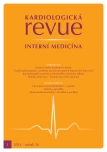Drug therapy in chronic kidney disease
Authors:
O. Zakiyanov 1,2; J. Vachek 1,3; V. Tesař 1
Authors‘ workplace:
Klinika nefrologie VFN a 1. LF UK v Praze
1; Ústav lékařské biochemie a laboratorní diagnostiky VFN a 1. LF UK v Praze
2; Farmakologický ústav 1. LF UK v Praze
3
Published in:
Kardiol Rev Int Med 2014, 16(1): 53-56
Category:
Internal Medicine
Overview
Chronic kidney disease belongs among the most frequent clinical problems, but often remains underdiagnosed. Decreased renal function affects all pharmacokinetic properties of drugs. Thus, patients with chronic kidney disease are at increased risk of adverse drug effects – especially overdoses of drugs that are primarily eliminated by the kidneys. Other frequent problems in patients with kidney disease are polymorbidity and polypharmacy. Before using any new medication, determination of the glomerular filtration rate is obligatory, since the value of serum creatinine alone is not a reliable indicator of kidney function. The dosing of drugs eliminated mainly or solely by the kidneys can be adjusted by reducing the dose, prolonging the interval between doses, or combining both these methods.
Keywords:
pharmacotherapy – pharmacokinetics – renal function – chronic kidney disease – dialysis – glomerular filtration
Sources
1. Coresh J, Selvin E, Stevens LA et al. Prevalence of chronic kidney disease in the United States. JAMA 2007; 298: 2038– 2047.
2. Kiberd B. The chronic kidney disease epidemic: stepping back and looking forward. J Am Soc Nephrol 2006; 17: 2967– 2973.
3. Stemer G, Lemmens‑ Gruber R. Clinical pharmacy activities in chronic kidney disease and end‑stage renal disease patients: a systematic literature review. BMC Nephrol 2011; 12: 35. doi: 10.1186/ 1471- 2369- 12- 35.
4. Boyer A, Gruson D, Bouchet S et al. Aminoglycosides in septic shock: an overview, with specific consideration given to their nephrotoxic risk. Drug Saf 2013; 36: 217– 230. doi: 10.1007/ s40264- 013- 0031- 0.
5. Kielstein JT, Burkhardt O. Dosing of antibiotics in critically ill patients undergoing renal replacement therapy. Curr Pharm Biotechnol 2011; 12: 2015– 2019.
6. Verbeeck RK, Musuamba FT. Pharmacokinetics and dosage adjustment in patients with renal dysfunction. Eur J Clin Pharmacol 2009; 65: 757– 773. doi: 10.1007/ s00228- 009- 0678- 8.
7. Corsonello A, Onder G, Bustacchini S et al. Estimating renal function to reduce the risk of adverse drug reactions. Drug Saf 2012; 35 (Suppl 1): 47– 54. doi: 10.1007/ BF03319102.
8. Björk J, Jones I, Nyman U et al. Validation of the Lund‑ Malmö, Chronic Kidney Disease Epidemiology (CKD‑ EPI) and Modification of Diet in Renal Disease (MDRD) equations to estimate glomerular filtration rate in a large Swedish clinical population. Scand J Urol Nephrol 2012; 46: 212– 222. doi: 10.3109/ 00365599.2011.644859.
9. Risch L, Hess B. Pitfalls bei Laborwerten – Elektrolyte, Harnstoff und Kreatinin. Ther Umsch 2013; 70: 457– 464. doi: 10.1024/ 0040– 5930/ a000432.
10. Jabor A, Straka L, Franeková J. Několik poznámek k současnému pohledu na určování eGFR. FONS 2009; 19: 27– 28.
11. Thomas MC. Diuretics, ACE inhibitors and NSAIDs – the triple whammy. Medical J Aust 2000; 172: 184– 185.
12. Grand'Maison A, Charest AF, Geerts WH. Anticoagulant use in patients with chronic renal impairment. Am J Cardiovasc Drugs 2005; 5: 291– 305.
13. Hart RG, Eikelboom JW, Brimble KS et al. Stroke prevention in atrial fibrillation patients with chronic kidney disease. Can J Cardiol 2013; 29 (7 Suppl): S71– S78. doi: 10.1016/ j.cjca.2013.04.005.
14. Farag A, Garg AX, Li L et al. Dosing Errors in Prescribed Antibiotics for Older Persons With CKD: A Retrospective Time Series Analysis. Am J Kidney Dis 2013. doi: 10.1053/ j.ajkd.2013.09.009.
Labels
Paediatric cardiology Internal medicine Cardiac surgery CardiologyArticle was published in
Cardiology Review

2014 Issue 1
Most read in this issue
- Acute kidney injury
- Selected renal diseases in pregnancy
- Rapidly progressive glomerulonephritides (crescentic glomerulonephritides)
- Drug therapy in chronic kidney disease
